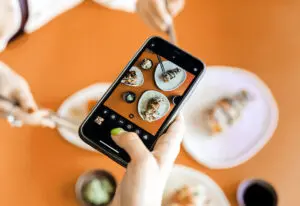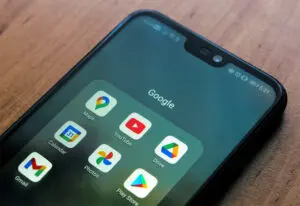
Never Miss a Moment With an Omnichannel Marketing Campaign
Before we pour ourselves a cup of coffee in the morning, most of us have had multiple interactions with technology. Maybe it starts with the chirp of your phone alarm that turns into an early morning social media scroll (#1), then transitions into firing up the laptop to check personal emails (#2) and switching on the news while the coffee pot percolates (#3). While you wait for the jitter juice to brew, you ask Alexa to play instrumental music (#4), bump up the heat on your smart thermostat (#5), and read a chapter on your Kindle (#6). In the brand world, the equivalent of this is omnichannel marketing. And we probably don’t need to tell you that if your customers are interacting with all these channels, your brand should be right there with them.
Why Omnichannel Marketing Is Your Brand’s Secret Weapon
If you learned Greek and Latin word origins in middle school, “omni” might ring a bell. Its literal meaning is “all,” and when used in the context of omnichannel marketing, it refers to brands having a presence across all channels—online and in real life. Not to be confused with its cousin “multichannel marketing.”
At this point in the digital age, you might be thinking “Well duh. Of course my brand should be on every channel.” But the secret sauce of this marketing approach is its seamless delivery and ability to authentically connect with each channel’s different audiences.
When done correctly, an omnichannel campaign can “bridge the gaps between the digital and physical worlds.”
In Case You Needed More Convincing, Its Benefits Include…
(But aren’t limited to)…
Connecting with more audiences: This goes beyond selling out your collections. It’s all about establishing meaningful relationships and having authentic interactions at each touchpoint. Many times, an omnichannel marketing approach will reveal new audiences you might not have considered.
Offering more seamless messaging: It can be jarring when a brand has a completely different persona online than in person. An omnichannel approach keeps messaging consistent and connected.
Creating brand loyalty: Customers will begin to trust your brand when you meet the above requirements (connection and consistency). And brand trust is a hop, skip, and jump away from lifelong brand loyalty.
Gaining better insights about audience members: People love variety. They also love a sense of choice and control. By marketing across platforms, you give your audiences more opportunities to engage with your brand on the channels they love most. This, in turn, gives you better insights into customer behavior.
Increasing profits: Mo’ channels, mo’ money? Essentially. Omnichannel campaigns increase sales, boost customer retention, and “reduce churn rates.”
Building an Omnichannel Campaign From the Ground Up
We could give you vague tips on how to build your omnichannel marketing campaign, but as visual learners, we love more concrete examples. For this exercise, we’re creating an example brand (fake but very real to us) to bring this campaign structure to life.
Here’s what you need to know:
- Brand name: Well Lived
- Industry: Health/wellness
- Primary audience: Gen Z
- Description: Well Lived is an e-commerce brand that creates curated wellness plans for its customers. After filling out an extensive questionnaire, the company matches a credentialed expert with the customer to create custom meal plans, vitamin supplements, skincare regimes, workout plans, and more.
Ready? Let’s dive in.
Have a solid foundation
To know thy brand is to know thyself—or something like that. Before starting a marketing campaign of any kind, you need to have a solid understanding of your brand and proven or perceived audiences. This goes beyond your basic industry know-how. You need a deep understanding of your mission, values, and differentiators. And be confident in your ability to solve an issue for your customers.
For Well Lived, it knows it has a strong footing with Gen Z. Health and wellness is the second highest category Gen Z spends their money on, after all. It also knows that it solves the issue of data overload for these young adults by helping them navigate the oversaturated wellness industry with personalized plans for a life well lived.
Create a strong web presence
In many ways, a good website is your brand’s nucleus. It’s where customers go to legitimize your brand, learn more, find products, and (for e-commerce) make purchases. Responsive web design is a digital-age must that includes stunning imagery, fast load times, compelling content, and easy-to-navigate buttons and menus.
Well Lived knows the importance of a visually pleasing website that appropriately describes the brand’s many services. The owners know customers will be looking for value before investing and want to see the brand’s legitimacy with privacy, certifications, and personalization.
Polish up your social channels
In addition to your website’s strong presence, your brand will need to bolster its engagement across social channels. When doing this, ensure the content and language are consistent but not rote and over-used. Don’t neglect your darlings, either. Customers will notice if you favor one channel (and its followers) over another.
Bringing it back to our example brand, although Gen Z is its primary audience, it also want to appeal to other age groups. That said, Well Lived is present on the channels most loved by Gen Z (TikTok, Instagram, and Snapchat) but has expanded its reach and messaging to Facebook, YouTube, Twitter (X), LinkedIn, and Pinterest.
Consider an app
We know, we know. Apps can be expensive and complicated undertakings. Not every brand needs an app, but it may be a natural next step for those that primarily sell products online. Your app might have exclusive features for customers, make the shopping experience smoother, or better integrate with other platforms.
If you’re pursuing omnichannel marketing as Well Lived, creating an app for ongoing services could help customers access their meal plans, meditation guidance, or one-on-one coaching more easily. Another benefit to users could be exclusive in-app partnerships with brands like Betterhelp, Hello Fresh, or Care/Of.
Pursue a mix of digital and physical
There are endless possibilities when it comes to omnichannel. Decide as a brand which avenues make the most sense for your marketing budget, audiences, and overall brand goals. This mix of digital and physical could include email, text messaging, social media, physical stores, physical advertisements (like billboards), and brand partnerships.
Seamlessly integrate messaging across platforms and channels
Regardless of which and how many marketing channels you pursue, or what the season, the messaging should be on-brand and consistent. However, you don’t want to simply copy, paste, and move on, make sure each channel has a device- and platform-appropriate CTA. Mix up the content just enough to show you’re paying attention to your audiences and where you are (watch tone, imagery, file sizes, etc.).
Well Lived has its biggest followings on TikTok and Instagram but is careful how it re-shares and re-frames content. Often, the brand will share TikToks on Instagram Reels but focus on unique (but related) content for the Feed.
Strengthen your customer experience and support
Paying attention to the above elements will naturally optimize the customer experience. But it’s never a passive job. Consider your customer at all stages of the buying journey and anticipate their needs. This could include 24/7 customer support, easy-pay options, or CRM software. It should, however, always include protecting your customer’s data.
To support its mission of providing for its customers, Well Lived integrated a chat function (run by a customer rep, not a bot) onto its app and website.
Don’t ignore the data
When working with a myriad of channels, the math will be mathing. In non-Gez Z terms, the numbers will be telling their own story. Opt for integrated data to better reach your customers, set key performance indicators (KPIs), conduct A/B tests, and make pivots when necessary when new trends come about.
Who’s Doing Omnichannel Marketing Right
As they say: “Show, don’t tell.”
Disney
We can’t talk about omnichannel marketing without talking about the queen (or is it princess?) itself: Disney. From its opening day in 1955 until now, Disney has been a master of innovation and reinvention. The Disney Parks experience alone is a lesson in omnichannel presence, from its responsive website, My Disney Experience tool, and the ever-popular Magic Band Program. Beyond this, Disney has countless brand partnerships, television channels, movie studios, and more.
It’s hard to think of a single platform or industry that hasn’t been touched by the happiest place on earth.
Target
Long-loved Target has a special place in Millennials’ and Gen Z’s hearts. The retailer understands the times and its target market (a big chunk of which is young moms) and is constantly making the shopping experience most pleasant and seamless. Recently, Targeted integrated Pinterest Lens into its mobile app so users could take a picture and find a similar product online or in stores. The move was a clever partnership that resulted in a better shopping experience and a 10 percent sales increase.
Benefit Cosmetics
The last omnichannel example is Benefit Cosmetics’ brow bar experience. As part of the brand’s UK-based BrowMobile campaign and competition, Benefit gave winners their own brow bars and hosted a beauty drive-thru with product samples and free eyebrow waxing. Building off this campaign, they created “Boss Brows,” which highlighted four unique activists and increased the popularity of its brow collection.
Savy’s Your Partner in All Things Marketing
If you’re reading through this blog before your coffee has made its final drip, you’re not alone. And if you’re a brand owner reading this, we’ll wait for the caffeine to kick in before the lightbulb goes off on omnichannel marketing to your audiences. When you’re ready, Savy has the experience and the creativity to pull off integrated campaigns that connect.
Recent Posts
Custom Website Design and Development vs. Off-the-Shelf: What’s Right for Your Business?
Having a website that represents your brand and serves your business effectively can make or break your success in 2025. This poses the important question: Should you opt for custom […]
Read MoreHow to Rebrand Your Instagram for Better Engagement and Brand Recognition
Your Instagram presence can act as a beacon for brand recognition and customer engagement. It’s about painting a picture so compelling that your audience cannot help but be drawn to […]
Read MoreFrom Clicks to Conversions: The Science of High-Performing Digital Ads
The journey from interest to purchase is often paved with digital advertisements. However, not all digital ads are crafted equally. While some fade into the background, others command attention and […]
Read MoreBrand Consistency Examples That Will Make You Rethink Your Marketing Strategy
A consistent and strategic brand identity across all platforms is not just beneficial; it’s essential. By exploring real-world brand consistency examples, we uncover the immense power of maintaining a coherent […]
Read More3 Ways to Transform Blogs With SEO and Make Google Love Your Content
As marketers and business owners, our goal is to ensure the blogs we publish confidently stride into the spotlight of Google’s top search results. Achieving this requires great content, but […]
Read More



